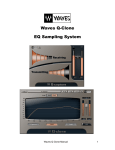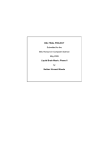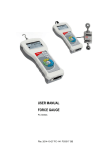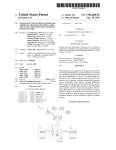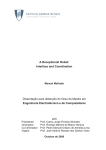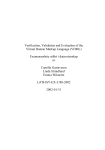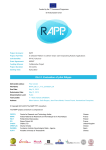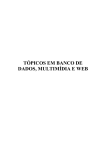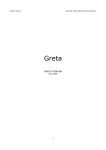Download Fuzzy Similarity of Facial Expressions of Embodied Agents
Transcript
Fuzzy Similarity of Facial Expressions of
Embodied Agents
Radoslaw Niewiadomski and Catherine Pelachaud
IUT de Monreuil, Universit´e Paris 8, France
{niewiadomski,pelachaud}@iut.univ-paris8.fr
Abstract. In this paper we propose an algorithm based on fuzzy similarity which models the concept of resemblance between facial expressions
of an Embodied Conversational Agent (ECA). The algorithm measures
the degree of visual resemblance between any two facial expressions. We
also present an evaluation study in which we compared the users’ perception of similarity of facial expressions. Finally we describe an application
of this algorithm to generate complex facial expressions of an ECA.
Keywords: Embodied Conversational Agents, facial expressions, fuzzy
similarity.
1
Introduction
The mystery of the human face inspired artists and psychologists for centuries.
Recently it has become also an object of interest of computer scientists. Embodied conversational agents (ECAs) – programs that focus on multimodal
communication between humans and machines – display facial expressions to
communicate. In this paper we focus on modelling the concept of similarity between any two facial expressions of emotion of an ECA. Despite facial expressions
are complex objects it is quite natural and easy for human beings to decide if
any two facial expressions are similar or not. Our aim is to build an algorithm
that simulates this human’s skill.
Establishing the degree of similarity between facial expressions can be very
useful for an ECA designer. Often the knowledge about facial expressions is
restricted only to some particular cases. Despite the evidence that many facial
expressions exist [13,15,19] most of researchers (e.g. [3,10,11]) limit their research
only to six of them, namely: anger, disgust, fear, joy, sadness, and surprise. Other
facial expressions were rarely studied, and as consequence they are difficult to
model. We used the algorithm presented in this paper to model different types
of facial expressions like fake or inhibited expressions for the expressions like
embarrassment, disappointment or contempt (see section 5).
Generally, similarity is very difficult to measure. It is a quantity that reflects
the strength of relationship between two objects. The similarity between two
objects is measured by comparing their attributes. Two cars are similar if both
have the same number of doors, are about 4 meters long, and both are red.
C. Pelachaud et al. (Eds.): IVA 2007, LNAI 4722, pp. 86–98, 2007.
c Springer-Verlag Berlin Heidelberg 2007
Fuzzy Similarity of Facial Expressions of Embodied Agents
87
Traditionally the similarity between, two objects is expressed through a distance
function. In this geometrical tradition two objects are similar if the distance
between them is small [25]. On the other hand, fuzzy similarity [5] is used to work
with objects characterised by loose description. Each object or feature that does
not have a precise definition can be described by a fuzzy set. Fuzzy similarity
allows for the comparison of any two fuzzy sets. It takes into consideration
the various features of objects that characterise them at least partly. Various
measures have been proposed to compare any two fuzzy sets [5].
For the purpose of comparing computer generated facial expressions we decided to use fuzzy similarity. It allows us to define attributes of an object by
fuzzy sets instead of using precise values. On the other hand, according to many
researchers (e.g. [10,16]) each “distinct and labelled expression of emotion” like
“expression of anger” or “expression of contempt” is rather a “class” or a “set”
of different but similar configurations of facial muscles actions (or a set of different facial displays). Indeed, there is not one precise smile or a frown. Each smile
is a little bit different but “all smiles” have some characteristics in common.
The boundary between smiling and not smiling is also imprecise. Different facial
displays of different intensities are classified as smiles. Indeed, in many experiments (e.g. [2,11]) different facial displays involving the same group of muscle
contractions were described by subjects with the same label, so an expression
of an emotion e.g. “expression of anger” is not a precise concept. It has an imprecise “fuzzy” definition (see also [26]). On the other hand, all facial displays
that belong to one category like “happiness”, “anger”, or “embarrassment” have
some common features. Therefore, any category can be defined by a set of fuzzy
sets that corresponds to these features.
Our approach follows the results from the psychological theory and experiments. It is based on the discrete-emotion approach represented among others
by Paul Ekman [7,10]. According to this theory there is only a discrete number
of expressions that can be universally recognized by humans. Ekman focuses
his research on the six facial expressions mentioned above. We decided not to
restrict ourselves to this small set. Thus our algorithm of similarity should work
properly with any facial expression as, for example, those described in [13,18,19].
Thus we aim at building an algorithm that:
– is coherent with the discrete-emotion approach and with the results of the
experiments about the perception of facial expressions,
– works for any facial expression,
– preserves the fuzziness of the concept of facial expression,
– preserves the different degrees of similarity between facial expressions.
The remaining part of this paper is structured as follows. In next section we
present some theoretical aspects of comparing facial expressions. In section 3 we
present our algorithm and in section 4 the evaluation study. The section 5 is
entirely dedicated to the applications of our algorithm. Finally conclusion and
future work are presented is section 6.
88
2
R. Niewiadomski and C. Pelachaud
Fuzzy Similarity
Fuzzy similarity offers a set of methods to compare two objects. As opposed
to distance-based similarity, each feature of an object is represented by a fuzzy
set. Two fuzzy sets can be compared using M-measure of comparison [5]. It
expresses the strength of the relationship between the features of two objects.
There are different types of the M-measures of comparison. For our application
we chose the M-measure of resemblance [5]. It is used for comparing objects of
the same level of generality. Using this M-measure it is possible to check whether
two objects “have many characteristics in common” [5]. It is often used in casebased reasoning systems. Each M-measure of resemblance S has also two other
properties:
– reflexivity: S(A, A) = 1 ,
– symmetry: S(A, B) = S(B, A).
These properties characterise also the process of comparing facial expressions.
First of all, comparing facial expressions means to compare objects of the same
level of generality. Following Ekman’s theory [10] all expressions are equiimportant and distinct. Moreover, in [20] it was found that the perception of
similarity between unlabelled facial expressions is symmetrical, i.e. expression A
is similar to expression B to the same degree as B is similar to A [20].
In [5] different M-measures of resemblance are proposed. For our application
we chose the measure of resemblance S defined by:
S(A, B) =
(M (A ∩ B))
(M (A ∪ B))
(1)
where A and B are two fuzzy sets (μA is membership function of A) and M is
the fuzzy measure on Ω:
μA (x)dx
(2)
M (A) =
Ω
This choice was made mainly because of practical consequences. This concrete
measure is easy to implement and the process of computation is relatively simple.
As a result we obtain the value of comparison xi ∈ [0,1] for each pair of attributes.
Following the approach proposed in [23] we use Ordered Weighted Averaging
(OWA) operator to aggregate all values x1 ,...,xn . The OWA, hW : [0, 1]n → [0, 1],
is defined as:
n
hW =
wi bi
(3)
i=1
where bi be i-th biggest value between x
1 ,...,xn and W = {w1 , ...., wn } is a set
n
of weights with wi ∈ [0, 1] and such that i=1 wi = 1 [23]. Finally, we use trapezoid fuzzy sets in order to describe the features of facial expressions as shown
in Figure 1. This shape renders the experimental results about perception of
facial expressions [2,27]. On the other hand, it is characterised by computational
facility.
Fuzzy Similarity of Facial Expressions of Embodied Agents
3
89
Similarity of Facial Expressions in an Embodied
Conversational Agent
In order to implement and test our algorithm we used an existing ECA architecture called Greta [4]. Facial expressions of Greta are described in terms of
facial animation parameters (FAPs) [21]. Originally Greta did not offer fuzzy
definitions of facial expressions. The static expressions used by Greta needed
to be fuzzified. For each FAP of each expression we have defined the fuzzy set
of plausible values. First, we have established for each facial feature (i.e. single
FAP) the amplitude of values that preserves the reliability and plausibility of
a particular movement. It means that for any feature we have established the
minimum x1 and the maximum x2 plausible values for any expression. Beyond
this range the movement is perceived as unnatural. Each fuzzy set FAPk of a
particular facial expression depends on this amplitude of plausible values. We
have established that membership is a symmetrical trapezoid with the centre
in the point v, where v is a value of the original expression (see Figure 1).
The dimensions of the trapezoid depend on the absolute value of the difference:
|x2 − x1 |. Using fuzzy definitions of facial expressions we count the value of sim-
Fig. 1. A fuzzy set of FAPi
ilarity between them. For that purpose we use the procedure described in the
previous section. Let FS(Exp(Ei ),Exp(Ej )) be the value of similarity between
two expressions Exp(Ei ) and Exp(Ej ). For each FAPk of Exp(Ei ) and Exp(Ej )
we have:
M (F APk (Ei ) ∩ F APk (Ej ))
(4)
f sk =
M (F APk (Ei ) ∪ F APk (Ej ))
where k = 1,...,n. Then:
F S(Exp(Ei ), Exp(Ej )) = hw (f s1 , ..., f sn )
(5)
where hw is OWA operator with the weights wk = n1 (see section 2).
Recapitulating, our algorithm works as follow: let Eu and Ew be two emotions whose expressions we want to compare. Thus we want to establish fuzzy
similarity between two static expressions: Exp(Ew ) and Exp(Eu ). Each Exp(Ei )
is associated with a number of fuzzy sets such that all plausible facial displays
90
R. Niewiadomski and C. Pelachaud
Fig. 2. Fuzzy similarity of facial expressions of Greta agent
a
b
c
Fig. 3. The example of comparing facial expressions
(in the sense of muscle contractions) for the emotion Ei are defined. That is, for
each parameter k of an expression of Ei there is a fuzzy set FAPk that specifies
its range of plausible values. Then the value of fuzzy similarity for each parameter of Exp(Ew ) and Exp(Eu ) is established. The M-measure of resemblance S
is used to find these similarity values. Finally, in the third step, all values are
combined by means of the aggregation operator hw (3).
Let us compare the three facial expressions shown in Figure 3. The values
of similarity between them are: S(A,B) = 0.6 and S(B,C) = 0.4. That is, the
expression A is more similar to B than C is to B. In Figure 3a, the lips are
extended with greater intensity than in Figure 3b. When comparing Figure 3b
and Figure 3c, the eye aperture in Figure 3b is more closed than in Figure 3c.
Moreover, in these two images, the eyebrows have different shapes. This explains
why the similarity between B and C is less than between A and B. The areas of
the facial expressions that vary among the three images are marked by a circle.
4
Evaluation
We have conducted an evaluation study to check if our algorithm models adequately the concept of the resemblance of static computer generated facial
Fuzzy Similarity of Facial Expressions of Embodied Agents
91
expressions. We are unaware of any similar experiment made on computer generated expressions of emotions. Previous evaluation studies of embodied agents
([2,6,17]) mainly analysed the perception of emotions from the computer generated facial expressions. Instead we focus on the process of comparison of any
two facial expressions (i.e. the perception of the common features and the differences between them). We avoid considering the problem of interpretation of
these facial expressions.
Our main aim is to verify if the values of the similarity established by our algorithm are consistent with human perception of the resemblance between facial
expressions. Our hypothesis was that values of fuzzy similarity are proportional
to those found by human’s perception. In particular, we expected to find that
our algorithm and human perception are concordant not only in evaluating if any
two expressions are similar to each other or not, but also that different degrees
of resemblance perceived are adequately modelled in our algorithm.
4.1
Objects of Comparison
Our objects of comparison are images the emotional facial expressions of the
Greta agent. Each image depicting facial expressions follows the same setting:
–
–
–
–
each image presents one facial expression of Greta,
only the face is visible in the image,
the face is directed at the observer,
a black background was used.
Each image was saved in jpeg format. An example of the image is presented
in Figure 4. In the experiment we used 22 different facial expressions. Each
expression is defined by a different combination of FAP parameters and by their
values. The expressions are created according to the descriptions presented in
the literature. Among others, we used all six facial expressions proposed by
Ekman as universally recognized expressions of emotions [7,10]. We used other
distinct facial expressions (e.g. [18]), as well as some variations of one expression
like “low-intensity-joy” and “high-intensity-joy”. The neutral expression is also
included (see [11]).
Fig. 4. An example of facial expression used in the evaluation study
92
4.2
R. Niewiadomski and C. Pelachaud
Procedure
In our evaluation study we asked participants to rate the degree of similarity
between different facial expressions. For this purpose we ascribed the images,
prepared according the procedure presented in the previous section, to ten sets.
Each set sl , l = 1,...,10, is composed of one reference expression and six facial
expressions that have to be compared with the reference one. It means that each
experiment session consists of 60 operations of comparison (i.e. ten sets of six
comparison pairs each). To have access to a greater number of participants, we
set up our experiment on the web.
One experiment session consists in passing through 10 different web pages.
Each of them presents one set of images sl (i.e. seven facial expressions). The
reference image is signalled by a yellow border and it is placed in the first row.
The next two rows contain expressions to be compared with the reference one.
After deciding the similarity degrees for all six pairs, subjects can pass to another
set. They cannot come back to the preceding sets (i.e. s1 - sl−1 ) and they cannot
jump to the next set sl+1 without providing answers to the current one.
The single images as well as sets of images sl were displayed in a random order.
Images were not labelled. The participation in the experiment was anonymous.
For each pair of images (i.e. reference object, compared object) subjects had to
choose the degree of similarity by using a set of predefined expressions defined in
natural language (five-point Likert scale, ranging from “not similar” to “equal”).
In the experiment we decided to avoid the use of numerical description of the
level of similarity as it is not used by people to refer to similarity.
Sixty persons participated in the experiment, but only 46 of them went
through all ten sets of images. We focused only on complete responses. Twenty
three participants from the 46 classified were women, the other 18 - men. The
remaining 5 persons did not specify their gender.
4.3
Results
The total number of answers was 2760. First of all, we found that different labels
were used by subjects with different frequency. The first label: “1 - Not at all”
that corresponds to the lowest degree of similarity occurred in nearly half of all
answers (46%). Other labels occurred from 10% to 16% of all responses.
In order to interpret the subjects’ answers we compared them with the values
returned by our algorithm. For this purpose we changed the responses given by
the subjects into numeric values. Then, we compared them with the values of
fuzzy similarity. We translated a discrete set of answers given by participants
to one value in the interval [0,1]. We assumed that labels are evenly placed
along this interval and for each degree of similarity we associated a weight. More
formally, for the purpose of measuring the answers of participants we introduced
the average similarity index. Let (A, B) be a pair of expressions in which A is
the reference and B is the compared object. Then ui is the number of answers
using a given label, i.e. u1 corresponds to the label “1 – Not at all” and u5 to
the “5 – Equal”. The average similarity index, yAB , is:
Fuzzy Similarity of Facial Expressions of Embodied Agents
5
yAB =
(wi ui ) − w1
5
i
i
(w5 − w1 )
5
93
ui
(6)
ui
i
where wi = i is the weight that corresponds to ui . Let us notice that the values
of yAB and the values of fuzzy similarity FS (see section 3) are in the interval
[0,1]. Let the vector [ai ] contains the values of our fuzzy similarity FS such that:
ai =FS(Ai , Bi ) and let the vector [bi ] be such that: bi =yAi Bi . First of all, we
measured the correlation between [ai ] and [bi ]. The overall value of correlation
(r) is 0.89. The average similarity index, yAB (i.e. subjects’ answers) is more or
less proportional to the fuzzy similarity values (see Figure 5). The higher the
index value is, the higher the fuzzy similarity value is as well. On the other hand,
certain pairs were evaluated significantly higher by the participants than by the
fuzzy similarity. For this reason we measured also the discrepancy between values
bi and ai . The mean difference between bi and ai :
n
(bi − ai )
i
n
(7)
is 0.09. At the same time the standard deviation of the difference [ai ] and [bi ] is
0.15. Finally, the average value of yAB is 0.35.
4.4
Discussion
The aim of our experiment was to verify if the degrees of the similarity of computer generated facial expressions established by our algorithm are consistent
with human perception of this phenomenon. Firstly, we compared the weighted
average of the subjects’ answers with the values of our algorithm. We found
that the human’s answers and our algorithm results are positively correlated
and that the correlation coefficient is high (0.89). Also other results show that
the human perception of the resemblance of facial expressions is modelled correctly by our algorithm. The average similarity index for 80% of the considered
pairs is different from the perfect value (represented by the main diagonal) by
0.2 at most. Moreover, the mean difference between subjects’ responses and our
algorithm results is relatively small (i.e. 0.09). It is less than half of the distance
between any two neighbouring degrees of similarity on the scale used by subjects
in this experiment. Thus, we can say that the values of fuzzy similarity tend to
be proportional to the subjects’ answers. The coarse-grained scale of similarity
used in this experiment probably influenced this result negatively. Subjects had
to choose from a discrete set of labels, as a consequence their answers can only
approximate the values of FS. The result is also influenced by the choice of the
method of ranking the subjects’ answers (i.e. yAB ). In particular, we assumed
arbitrally that the distance between any two degrees of similarity was constant.
94
R. Niewiadomski and C. Pelachaud
Fig. 5. Correlation between the fuzzy similarity and the average similarity index
On the other hand, the mean difference between subjects’ responses and our
algorithm results is positive. It means that the algorithm has a tendency to evaluate certain pairs of expressions as less similar in comparison with the subjects’
choices. Indeed, we noticed certain pairs that have the fuzzy similarity value in
the interval [0.3,0.5] were evaluated as relatively more similar than our algorithm
indicates. Indeed, as shown in Figure 5 more points in this interval are situated
above the diagonal than under it.
5
Application
In the previous section we have presented an innovative algorithm, which allowed
us to compare any two facial expressions of an embodied agent. In this section we
present an example of its application. We use it to generate different types of facial expressions (e.g. expressions of masking or fake expressions). Previous models [1,26] of facial expressions deal with the display of emotional states. They are
based on the assumption that emotions which are similar (for instance in terms of
valence or arousal values) have also similar expressions. On the contrary, we propose that the visual resemblance between two facial expressions is the measure
that can be used in order to generate a new expression. We used our fuzzy similarity based algorithm in order to generate different types of facial expressions.
There is a large amount of evidence in psychological research that human’s
repertoire of facial expressions is very large [9,15,22]. Facial expressions do not
always correspond to felt emotions but they can be fake (showing an expression
of an unfelt emotion), masked (masking a felt emotion by an unfelt emotion), superposed (showing a mixed of felt emotions), inhibited (masking the expression
of emotion with the neutral expression), suppressed (de-intensifying the expression of an emotion), or exaggerated (intensifying the expression of an emotion)
(see [20] for detailed discussion). We called complex facial expressions expressions that are combinations of several facial displays. It was shown that humans
can distinguish the expression of felt emotion from the expression of fake emotion or from a masked one [9,12,14,22]. In fake expressions some elements of the
Fuzzy Similarity of Facial Expressions of Embodied Agents
95
original expression are missing [10], while certain elements of expression of the
felt emotion can be still visible even if that expression is masked or inhibited [8].
We proposed [4] a model to generate complex facial expressions (e.g. fake expression of anger or expression of sadness masked by joy) on the basis of simple
expressions (e.g. sadness, joy). This model of complex facial expressions is based
on Ekman’s results [7,10].
We model complex facial expressions using a face partitioning approach. The
face is divided in eight facial areas Fi , i= 1,..,8 (i.e., F1 - brows, F2 - upper eyelids,
F3 - eyes, F4 - lower eyelids, F5 - cheeks, F6 - nose, F7 - lips movement, F8 lips tension, see Figure 6). Each facial expression is a composition of these facial
areas, each of which can display signs of emotion. For complex facial expressions,
different emotions (as in an expression masked another one) can be expressed on
different areas of the face (in the example of sadness masked by anger, anger is
shown on the eyebrows area while sadness is displayed on the mouth area). In our
model complex facial expressions, involving one or more emotions, are composed
of the facial areas of the input expressions using a set of rules. Our model can be
used to generate different displays for the facial expressions of masking, as well
as fake and inhibited expressions. These complex facial expressions involving
the six emotions (anger, disgust, fear, joy, sadness, and surprise) are described
in the literature [7,10]. For each type of expression we have defined a set of
fuzzy rules that describes its characteristic features in terms of facial areas.
To each emotion corresponds a rule. Thus we have defined six rules for each
type of complex facial expression. In case an input expression for which the
deceptive facial expression is not defined explicitly by our rules (e.g. expressions
of contempt or disappointment) our fuzzy similarity based algorithm presented in
the previous sections is used in order to establish the degree of similarity between
the input expression and the expressions whose complex facial expressions are
described by our rules. Once the most similar expression (chosen among the 6
ones) is known, we can apply the corresponding rules to our input expression. For
example, when we want to compute the complex facial expression of contempt or
of disappointment, we look to which expression of the six-elements set mentioned
above it is the most similar to and we use the associated rule. Thus masked,
Fig. 6. The partition of the face
96
R. Niewiadomski and C. Pelachaud
inhibited or fake facial expressions of two similar facial expressions are created
using the same rules.
Figure 7b presents the agent displaying the expression of disappointment
masked by a fake happiness. Our rules describe the expression of masked sadness but they do not define masked disappointment. We applied algorithm fuzzy
similarity and found that disappointment has a facial expression very similar to
sadness. According to Ekman [10,7] the features of felt sadness that leak over the
masking expression are: forehead, brows, and upper eyelids. In our model these
elements of expression are represented by the facial areas F1 (forehead and brows)
and F2 (upper eyelids). As a consequence, they can be observed in masked sadness. On the other hand, the expression of disappointment (Figure 7a) is very
similar (according to the algorithm described in section 3) to the expression of
sadness and so the rules of sadness will be applied also in the case of disappointment expression. Indeed in the expression of disappointment masked by fake joy
(Figure 7b) we can notice the movement of brows, which is characteristic of disappointment. On the other hand the mouth area displays a smile (sign of happiness).
a
b
Fig. 7. Examples of expressions: a) disappointment and b) disappointment masked by
a happiness
6
Conclusion
In this paper we have presented how fuzzy similarity can be used to compare
facial expressions of an embodied agent. In our approach any facial expression
is described by a set of fuzzy sets. Using our algorithm we are able to compare
expressions i.e. the vague and imprecise objects described by certain labels. The
main advantage of this approach is that slightly different facial displays can be
described by one significant label. Then using fuzzy similarity we compare these
imprecise definitions and establish the degrees of similarity between them. We
are unaware of any other applications of the fuzzy similarity for the purpose of
comparing facial expressions.
We have also conducted a test to measure the perception of similarity between
facial expressions. We checked if the perception of similarity between computer
generated facial expressions is consistent with the values that are obtained with
Fuzzy Similarity of Facial Expressions of Embodied Agents
97
our algorithm. The results of the test showed that the algorithm based on the
fuzzy similarity meets our expectations. Finally we have also presented an application of our algorithm for generating facial expressions.
It is important to stress that in a more realistic model of similarity one should
take into consideration also the probability of occurrence of certain values for
a FAP. It means that even if a fuzzy set defines plausible values for a certain
expression it does not mean that all these values occur with the same frequency.
The similarity between two objects has to take into account the probability of
occurrence of the values from the given interval (see [24]) to avoid for instance
that two attributes “become similar” because of similar values but that occur
very seldom. Unfortunately, we do not have the data of this type for facial
expressions. In this situation we assumed that all values are equi-probable.
In the future, we aim to create fuzzy definitions of facial expressions based
on empirical data. Consequently, the shapes of the fuzzy sets that describe the
features of facial expression will be uniquely defined for each expression (see
[26]). All parts of the face are considered as equi-important in our similarity
algorithm at current stage of development. However, it is known that each face
areas of the face can have a different role in the perception of emotion ([3,6]).
We want to test if it is also the case for the perception of similarity.
Acknowledgement. We are very grateful to Giulianella Coletti and to Andrea
Capotorti for their help on fuzzy methods. We also thank Elisabetta Bevacqua
and Maurizio Mancini for implementing the Greta system. Part of this research is
supported by the EU FP6 Network of Excellence HUMAINE (IST-2002-2.3.1.6)
and by the EU FP6 Integrated Project Callas (FP6-2005-IST-5).
References
1. Albrecht, I., Schr¨
oder, M., Haber, J., Seidel, H.: Mixed feelings: expression of nonbasic emotions in a muscle-based talking head. Virtual Reality 8(4), 201–212 (2005)
2. Bartneck, C., Reichenbach, J.: Subtle emotional expressions of synthetic characters,
International. Journal Human-Computer Studies 62(2), 179–192 (2005)
3. Bassili, J.N.: Emotion recognition: the role of facial movement and the relative
importance of upper and lower areas of the face. Journal of Personality and Social
Psychology 37(11), 2049–2058 (1979)
4. Bevacqua, E., Mancini, M., Niewiadomski, R., Pelachaud, C.: An expressive ECA
showing complex emotions. In: Proceedings of the AISB Annual Convention, Newcastle, UK, pp. 208–216 (2007)
5. Bouchon-Meunier, B., Rifqi, M., Bothorel, S.: Towards general measures of comparison of objects. Fuzzy sets and systems 84(2), 143–153 (1996)
6. Constantini, E., Pianesi, F., Prete, M.: Recognizing Emotions in Human and Synthetic Faces: The Role of the Upper and Lower Parts of the Face. In: Proceedings
of the 10th International Conference on Intelligent User Interfaces, San Diego,
California, USA, January 10-13, pp. 20–27 (2005)
7. Ekman, P.: The Face Revealed. Weidenfeld & Nicolson, London (2003)
8. Ekman, P.: Darwin, deception, and facial expression, Ann. N.Y. Acad. Sci. 1000,
205–221 (2003)
98
R. Niewiadomski and C. Pelachaud
9. Ekman, P., Friesen, W.V.: The Repertoire of Nonverbal Behavior’s. Categories,
Origins, Usage and Coding, Semiotica 1, 49–98 (1969)
10. Ekman, P., Friesen, W.V.: Unmasking the Face. A guide to recognizing emotions
from facial clues. Prentice-Hall, Inc, Englewood Cliffs, New Jersey (1975)
11. Etcoff, N., Magee, J.: Categorical perception of facial expressions. Cognition 44(3),
227–240 (1992)
12. Frank, M.G., Ekman, P., Friesen, W.V.: Behavioral Markers and Recognizability
of the Smile of Enjoyment. In: Ekman, P., Rosenberg, E.L. (eds.) What the Face
Reveals: Basic and Applied Studies of Spontaneous Expression Using the Facial
Action Coding System (FACS), Oxford University Press, Oxford (1995)
13. Gonzaga, G.C., Keltner, D., Londahl, E.A., Smith, M.D.: Love and commitment
problem in romantic relation and friendship. Journal of Personality and Social
Psychology 81(2), 247–262 (2001)
14. Gosselin, P., Kirouac, G., Dor´e, F.Y.: Components and Recognition of Facial Expression in the Communication of Emotion by Actors. In: Ekman, P., Rosenberg,
E.L. (eds.) What the Face Reveals: Basic and Applied Studies of Spontaneous
Expression Using the Facial Action Coding System (FACS), pp. 243–267. Oxford
University Press, Oxford (1995)
15. Haidt, J., Keltner, D.: Culture and facial expression: Open-ended methods find
more expressions and a gradient of recognition. Cognition and Emotion 13(3),
225–266 (1999)
16. Izard, C.E.: Human emotion, Plenum Press, New York (1977)
17. K¨
atsyri, J., Klucharev, V., Frydrych, M., Sams, M.: Identification of synthetic and
natural emotional facial expressions. In: ISCA Tutorial and Research Workshop on
Audio Visual Speech Processing (AVSP’03), St. Jorioz, France, pp. 239–244 (2003)
18. Keltner, D.: Signs of appeasement: Evidence for the distinct displays of embarrassment, amusement, and shame. Journal of Personality and Social Psychology 68,
441–454 (1992)
19. Matsumoto, D.: More evidence for the universality of a contempt expression. Motivation and Emotion, 16(4), 363–368 (1992)
20. Niewiadomski, R.: A model of complex facial expressions in interpersonal relations
for animated agents, Ph.D. thesis, University of Perugia (2007)
21. Ostermann, J.: Face Animation in MPEG-4. In: Pandzic, I.S., Forchheimer, R.
(eds.) MPEG-4 Facial Animation - The Standard Implementation and Applications, pp. 17–55. Wiley, England (2002)
22. Poggi, I.: Interacting bodies and interacting minds. In: 2nd lInternational Society
for Gesture Studies (ISGS) Conference Interacting Bodies, Lyon, pp. 15–18 (2005)
23. Rifqi, M.: Mesures de comparaison, typicalit´e et classification d’objets flous: th´eorie
et pratique, Ph.D Thesis (1996)
24. Scozzafava, R., Vantaggi, B. (eds.): Fuzzy Relations in a Coherent Conditional
Probability Setting, 7th International Conference on Information and Management
Sciences (IMS), Chengdu, China, pp. 496–500 (2006)
25. Teknomo, K.: Similarity Measurement, http://people.revoledu.com/kardi/
tutorial/Similarity/index.html
26. Tsapatsoulis, N., Raouzaiou, A., Kollias, S., Crowie, R., Douglas-Cowie, E.: Emotion Recognition and Synthesis Based on MPEG-4 FAPs. In: Pandzic, I., Forchheimer, R. (eds.) MPEG-4 Facial Animation - The standard, implementations,
applications, John Wiley & Sons, UK (2002)
27. Young, A.W., Rowland, D., Calder, A.J., Etcoff, N.L., Seth, A., Perrett, D.I.:
Facial expression megamix: tests of dimensional and category accounts of emotion
recognition. Cognition 63(3), 271–313 (1997)













